Panel 3 : Commercial meeting point
An active port
Contrary to what one might think today, for many centuries, the commercial traffic of the port was not solely focused on the wine trade.
Between 1272 and 1273, King Edward I carried out a census of the feudal rights collected in his domains in Aquitaine. This survey shows that a wide variety of goods were traded in Libourne, including raw materials such as iron, copper, lead and other metals, and finished products such as pottery and glassware, leather, cloth and fabrics, as well as all kinds of livestock.
The importance of this trade explains why the urban development and construction of the fortified town began near the rivers. In the Fozera district, the Rue des Chais (whose name has remained unchanged since the Middle Ages) preserves the memory of the sheds and warehouses which lined it.
The port provided work for many different kinds of craftsmen and workers. Some of these professions were based on the many boats which required maintenance and supplies. They included sailmakers, ropemakers, blockmakers and boat-builders.
Other professions focused on navigation and port operations and included sailors, stevedores, shipmasters and dockers, as well as port police officers. The ‘saquiers’ (salt measurers) held a special place among the dockers.
The Brotherhood of ‘Sacquiers’
Some of the port's porters were assigned to loading and unloading ships carrying salt. These were the ‘sacquiers’.
The Brotherhood of ‘Sacquiers’, created at the start of the 15th century, included both men and women. This is illustrated by a sign which survives to this day and which shows ‘the names of members in alphabetical order of first names’. The brotherhood received the king's favour in 1451 through letters patent confirming their status and privileges.
The sacquiers enjoyed an important privilege, namely that of taking on behalf of their profession ‘one man's load of salt from each boat, vessel or ship carrying salt arriving and unloading at the port and harbour of Libourne’. Also known as the ‘sainte goutte’ (sacred drop), this privilege was only abolished in 1742.
The privilege bestowed to the sacquiers was all the more important as, since the 14th century, Libourne had been one of those rare ports where the salt trade was authorised by royal privilege, resulting in a monopoly which for a long time contributed greatly to the prosperity of the town, as salt was essential for the preservation of food.
Income from the ‘sainte goutte’ enabled the sacquiers to finance a brotherhood and to maintain a chapel built in the church of Saint-Jean. They celebrated many services there, in particular on 15 January, 3 February and 25 August, which were the official feast days of their patrons: Saint Maur, Saint Blaise and Saint Louis.
In addition to these religious ceremonies, the sacquiers, thanks to their income, also practised the principles of mutual aid and charity within their trade which pre-dated our modern social insurance. They took responsibility for ‘assisting the old and infirm in all their needs, for burying them and praying to God for the peace of their souls, and for providing for their widows, without which they would most often be reduced to extreme poverty in the prime of their lives, having for the most part only the strength of their bodies’. The harsh working conditions were exhausting for these port workers. The conditions ‘cause almost all of them to die at the age of about fifty or to be incapacitated at that age’.
